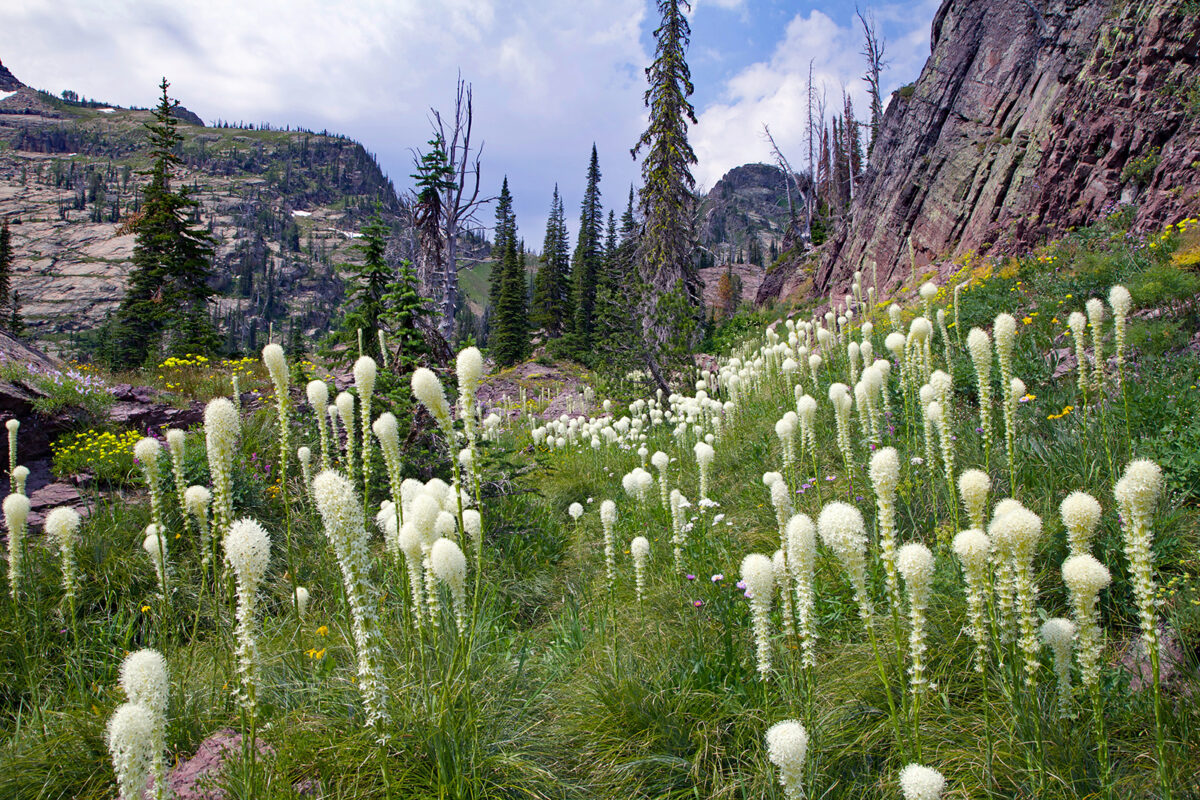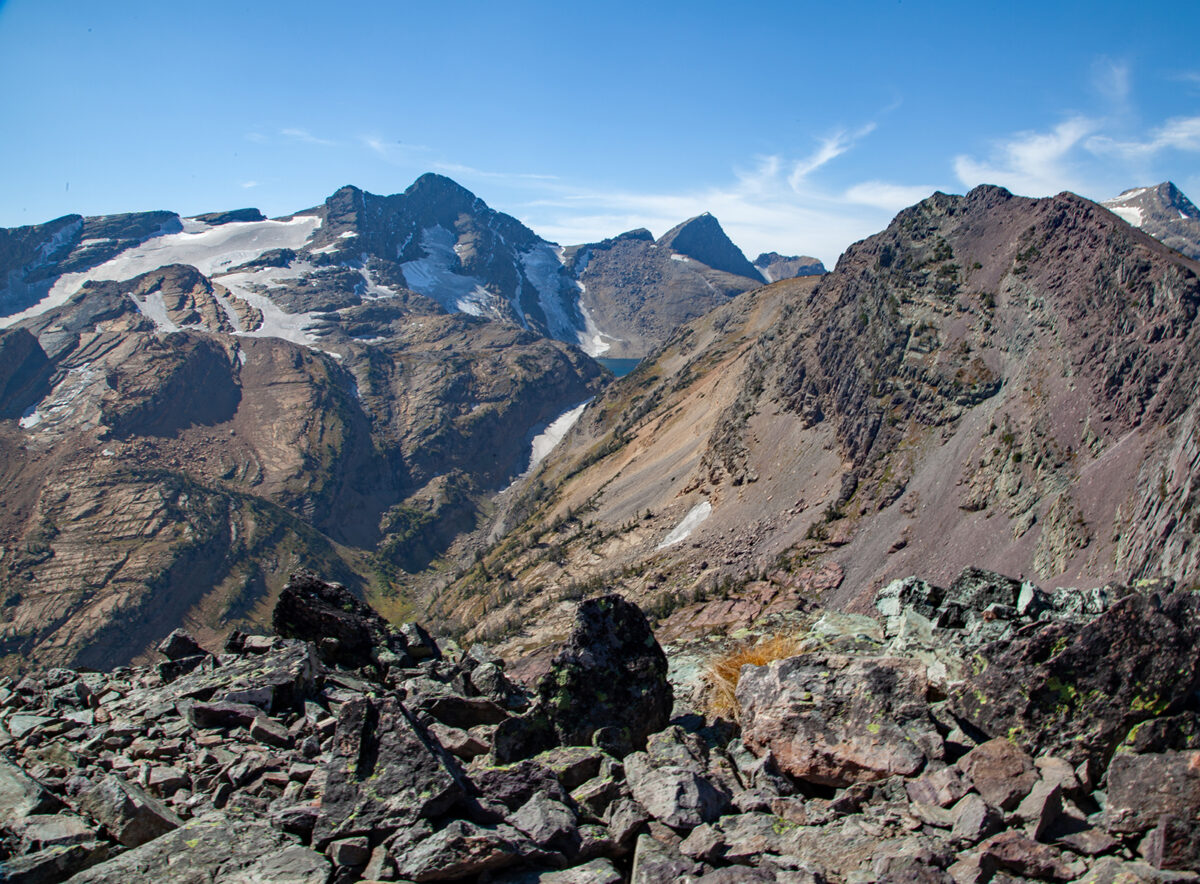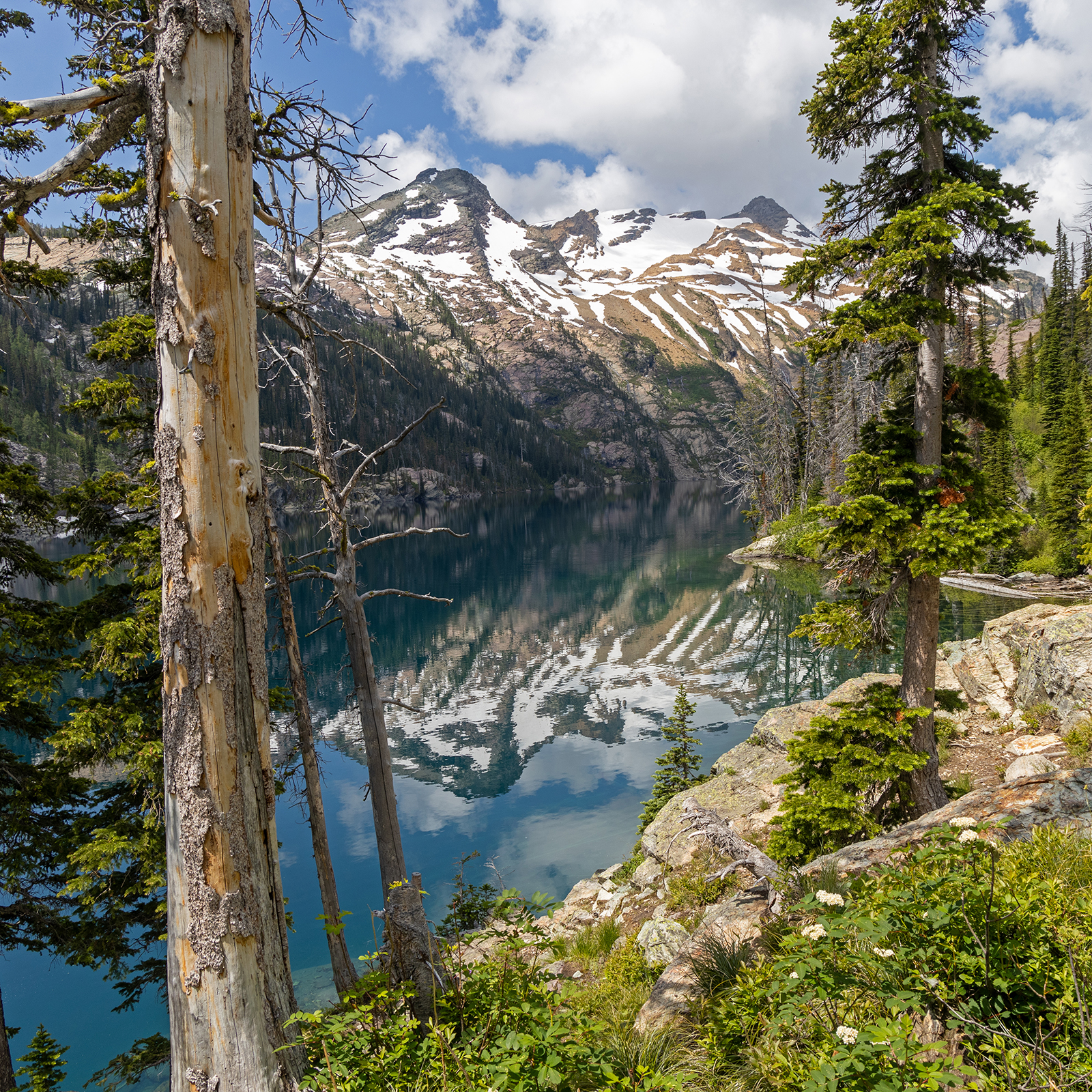Fifty years ago, 73,877 acres of the Mission Mountains area were designated as wilderness, defined as, “an area of undeveloped Federal land retaining its primeval character and influence, without permanent improvements or human habitation, which is protected and managed so as to preserve its natural conditions.” Fifty years as designated wilderness, but thousands of years a wild place, sculpted during the Ice Age 10,000 to 15,000 years ago.
Rugged mountains blanketed with year-round glaciers and perennial snowfields rise above turquoise lakes. Waterfalls spill into creeks that wind through deep forests of fir, cedar, spruce, larch and pine trees. Above the tree-line lies nature’s architecture of massive slabs of red rock, steep ledges, jagged aretes, hanging basins and snow-filled cirques. Hiding over the next rise you might discover a hidden pool amid a grassy meadow spattered with colorful wildflowers. It is a wild and wonderful place that stops you in your tracks –– then beckons you to go farther.
Before the arrival of the white man in the early 1800s, it was the aboriginal territory of the Confederated Salish and Kootenai Tribes. Archaeologists have documented sites that reveal continuous occupancy as long as 12,600 years ago. Ancient tribal stories hint that their ancestors were there when the ice age began 40,000 years ago.
The broad Mission Valley rises quickly to nearly 10,000-foot mountains which are home to a wide variety of animals including grizzly and black bear, wolverine, lynx, mountain goats, elk and deer, fish and other water creatures, and a wide variety of birds. The Mission Valley and surrounding mountains were historically part of the tribe’s borderless home where they hunted, fished and gathered berries and plants to feed their families. They traveled over the Mission Mountains to the plains for an annual buffalo hunt. It was also a medicine place where they gathered medicinal herbs and found solitude while on mission quests, searching for answers and purpose.
The Mission Mountain range earned its name because of its proximity to St. Ignatius Mission, first established in 1854 by Jesuit priests. Today there is an invisible line that divides the Mission Mountains to form two wilderness areas managed by two different entities. The eastern side is managed by the U.S. Forest Service, while the western side is managed by the Confederated Salish and Kootenai Tribes.
The westward migration and white man’s arrival made it necessary to establish boundaries for the new activities in this formerly undeveloped place. The 1891 Forest Reserve Act was implemented to establish forest reserves, to protect wooded areas from logging and other uses, followed by the formation of the Flathead Forest Reserve in 1897.
The natural beauty and resources of the area attracted a variety of people for a variety of reasons. The first white men to spend time in this wild place were fur trappers including David Thompson, Jocko Finley and John Howe in the early 1800s.
In 1901 Morton Elrod, founder of the Yellow Bay Biological Station on Flathead Lake, led the first scientific exploration of the Mission Range.
In 1922 a group of photographers and writers were guided by Theodore Shoemaker and Jack Clack to scout the area for the Northern Pacific Railroad Company, which owned several thousand acres at the time, for the purpose of promoting the area for tourism. This was followed by further exploration by Montana Mountaineers, a hiking and climbing club led by Shoemaker in 1923 and 1924. After these expeditions, Shoemaker created a map of a large portion of the high country in the Missions.

Bob Marshall, famed for his phenomenal hiking ability and namesake to the Bob Marshall Wilderness, was also one of the earlier explorers here. After spending five days in the Swan Mountains in the summer of 1928, Bob Marshall journeyed across the Swan Valley to explore the Mission Mountains. During the next two days he hiked 76 miles, climbed at least seven peaks and visited many of the numerous lakes that are scattered throughout the Mission Mountains.
The first effort to preserve the eastern slopes of the Missions came in 1931 when it was established as a Primitive Area prohibiting development in order to preserve it in in its natural state. Five years later the first tribal council proposed to set aside 100,000 acres of the western slope as a tribally-managed park, but this plan wasn’t completed. Over 50 years later, in 1982, the Tribes formally established 89,500 acres of the western slope as wilderness. It was the first tribal wilderness in the nation. Access to this area requires a tribal permit and portions of the wilderness are closed during specific times of the year to protect grizzly bear habitat.
On the other side of the mountains, the Swan Valley continued to be settled and use of the high country increased as families settled here for the simplicity of life and spectacular natural beauty of the area. They often relied on hunting, fishing, berry-picking for their sustenance as well as enjoying these activities for recreational reasons.
The “Montana Voices of the Swan” history book chronicles stories that paint the picture of life in this area in the 1940s and into the next century. Interviews include colorful stories of the trials and tribulations of living in such a wild and wooly place. Early residents tell of phenomenal fishing in places such as Glacier Lake, a noise in the night that a group of campers thought was Bigfoot lurking outside their tent, the crash of a patrol plane near Cedar Lake that killed three, and a missing mountain goat researcher working near Lost Lake who was never found.
Prior to the 1960s, most of the trails were built for fire management. They began at the valley floor naturally limiting the use of the high reaches of the Missions, except to stockmen. This changed when roads were built for logging 200 acres on the eastern boundary of the Primitive Area to remove trees infested by spruce bark beetles to prevent their spread. After this, some of these roads were used to offer trailheads at higher elevations, allowing easier access to the Primitive Area. Visitor-use recorded in 1963 show that 2,370 people visited the Primitive Area that year.
In 1975 the eastern side of the Primitive Area was officially classified as wilderness. U.S. Forest Service ranger Cal Tassinari became the first official wilderness ranger and wrote the first wilderness management plan for this area. The basics of this plan are still used today. Tassinari mentored Kari Gunderson and in 1996 she became the first contracted wilderness ranger in the nation with her partner Joe Flood, patrolling the Mission Wilderness as Gunderson/Flood Wilderness Partnership. After 35 years as a wilderness ranger, in 2015 Gunderson passed the baton to Daughters of the Sun Backcountry Services to complete on-the-ground land stewardship.
Today, trails bear the brunt of their popularity. During peak use times in July and August, the parking lot at the popular Glacier Creek trailhead spills over and cars snake down the road. On a busy day hundreds of people might travel along this trail system.
Solitude can be fleeting as the sounds of cheerful, chatty hikers drift up and down from switchback trails and a stream of hikers on the trail make it necessary to shuffle to the side. Fire rings fill with half-burned tinfoil and other trash. Human waste and tissue often go unburied. In recent years it was necessary to ribbon off restoration sites along the some of the lakes where vegetation was beat down and the soil compacted. Camping is no longer allowed along Upper and lower Cold Lakes and Glacier Lake.
Even though wilderness is, “recognized as an area where the earth and its community of life are untrammeled by man, where man himself is a visitor who does not remain,” it is surely not untrammeled and unchanged as this hidden treasure gets discovered more rapidly than ever through social media and a growing population of both residents and tourists. Administrators are faced with the conundrum of protecting personal freedom while attempting to protect the integrity of a wild place.
Wilderness rangers appear to share a commonality that places dedicated stewards in the midst of this precious wilderness. For them, it is not just a job; it is a lifestyle. It is their passion. Two key players in the Mission Mountain Wilderness stewardship today are a testimony to this fact.

Nathan Noble has been a wilderness ranger with Daughter of the Sun Back Country Services (DOTS) for the past 11 years and Luke Lamar was a wilderness ranger for 12 years before he began working full time at Swan Ecosystem and then at Swan Valley Connections, where he is administrator of the DOTS contract.
Both men grew up playing on different sides of the mountain –– Noble on the west side, accessed from his Polson home; and Lamar on the east side, while growing up near Condon. They developed an intimate relationship with the Mission Mountain Wilderness as they roamed the backcountry as if it was their big backyard. Their paths intercepted when they both grew up to be stewards of this spectacular place that framed their childhoods and ended up determining their futures.
Noble shares, “I am very sentimental about the Missions. It is something that raised me. It is my beacon in life.” His personal and professional life has revolved around the Missions. It is almost as if he used a drawing compass to find his way. With its point in the Mission Mountains, he has circled around the Mission Mountains his entire life, living on both sides of the range and never very far away. He says, “I can’t imagine life without that mountain range.”
After a dozen seasons as wilderness ranger, Lamar acts as manager and director of conservation and operations at Swan Valley Connections, a nonprofit organization promoting conservation and stewardship in the Swan Valley. His job includes working as administrator of the contract work in the Missions completed by Daughters of the Sun Backcountry Services, which is owned and operated by Noble along with Kaydee Borcher.
As trail stewards their tasks include maintaining 47.4 miles of trails and trailheads, completing campsite naturalization, and visitor education. Lamar notes that visitor education is probably the most important part of the job. While on the trail, rangers offer advice and correction to hikers in order to protect the wilderness area as well as helping visitors stay safe.
Trailhead signs often broadcast “Leave No Trace” principles. This detailed seven-point guide, aimed at minimizing impact in the wilderness, offers a more practical and specific expectation of the somewhat romantic idea of leaving a place “untrammeled.” These principles include:
- Plan ahead and prepare
- Travel and camp on durable surfaces
- Dispose of waste properly
- Leave what you find
- Minimize campfire impacts
- Respect wildlife
- Be considerate of others

Nature imposes her own restrictions off trail with vast, untamed, rough terrain, which limits use except for the hardiest most experience hikers. Lamar says, “Compared to most wilderness areas, it is incredibly wild.” When you venture off-trail, he says, “You earn it.”
For some, this element is what makes wilderness so appealing. Noble says he can be navigating a pile of jack-strawed trees clogging the trail and still find tranquility. “It’s all sweat and bugs and I still have the feeling that I am lucky to be paid to do this job,” he said, adding that at the end of the day, “It brings me so much peace.”
Lamar said he has an incredible admiration for the place. “I am glad for the people before me who designated it as wilderness.” As a kid, Lamar said he first fell in love with the tangible parts of his wilderness experiences –– the string of fish and knowing where the elk hung out. As he grew up, it grew into something less tangible. It was the feeling he got when he could see over the next ridge, the sense of discovery, and the piecing it all together. It was the interconnections –– and the amazing feeling of being connected to it all.
